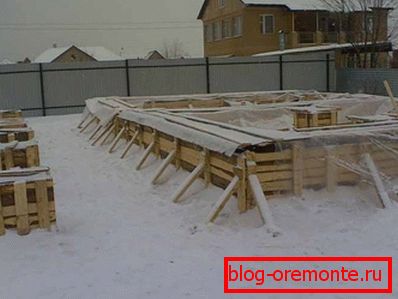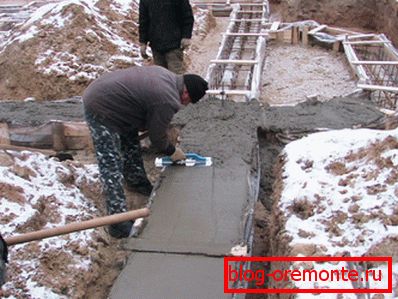Pouring concrete at sub-zero temperatures: features and
Pouring concrete is an integral part of most construction work. As you know, the ideal period for repair and construction work is a warm season and pouring concrete is no exception to this rule. However, what should be done by those who decided to continue construction, despite the freezing weather?
Pouring concrete into sub-zero temperatures is in most cases contraindicated by SNiP standards, since extreme cold does not fully polymerize compositions that contain liquid. But in some cases, the circumstances are such that the concrete must be poured, no matter what. And the question is quite natural, is it possible to pour concrete at sub-zero temperatures?

For areas where there is no warm season or situations in which winter construction is vital, there are several technological solutions through which concrete structures can be formed without sacrificing quality. In this article, you will be given detailed instructions on how to pour concrete in sub-zero temperatures.
Pouring concrete

At sub-zero temperatures, the liquid in the cement mortar freezes, and ice crystals break the crystal lattice of the concrete, thereby weakening the strength of the future structure. After thawing, the structure of bonds is not restored, and the design loses a significant part of the strength potential, up to complete destruction.
Direct impact of sub-zero temperature on the concrete structure is permissible only after it acquires the required amount of strength, frost resistance, etc. In construction terminology, this value is called the threshold of critical strength - after overcoming it the frost does not adversely affect the structure of the concrete structure.
The threshold of critical strength is determined depending on the brand of concrete solution. The standard cement mixture M400 should gain at least 30% of its maximum strength and the lower the concrete grade, the higher should be the percentage of the strength of the concrete structure.

Before pouring concrete into sub-zero temperatures, it is necessary to create conditions that will prevent it from freezing. There are several technologies that help create or maintain the temperature necessary to overcome the threshold of critical strength.
Among them are the following:
- Heating mixture. Before pouring concrete at a minus temperature, the solution is heated to a certain state, which gives it the opportunity to overcome the limit of critical strength as it cools;
- Internal heating. Maintain positive temperature in reinforced concrete structures can be through internal electric heating, which is carried out by electricity and metal components;
- External heating. It is possible to create the temperature necessary to achieve the critical strength by using external steam or electric heating of the concrete;
- Thermal insulation. Concrete pouring at minus 5 degrees can be done with the help of high-quality insulated formwork, which does not release heat from the inside and allows cold to get inside;
- The use of specialized additivesthat prevent water from freezing.

Each of these technologies has its own characteristics that must be considered, giving them their preference. Consider the above options in more detail.
Heating mixture
The concrete solution is mixed in heated water, the temperature of which can be from 60 to 90 degrees. This technology can be used only if the ambient temperature does not fall below - 15 degrees. This circumstance should be taken into account if you are wondering, “At what subzero temperature can you pour concrete?”

Specialty Blends
Various antifreezes are added to the cement mixture, which prevent the formation of ice crystals. Most often, calcium chloride or sodium chloride (table salt) is used for this purpose, which can be no more than 2% of the total mass of the components. If the temperature does not fall below 15 degrees of frost, then the modifying additives will save the design from freezing.
Note! Despite the fact that the price of modifying components is quite affordable - it is best to buy factory mixes that guarantee the technical qualities of the product. Homemade recipes, mixed with their own hands, can be a waste of resources.
Thermal insulation

If you want to pour the foundation at minus temperatures, you can do without heating or third-party additives. It is enough to heat insulate the formwork with sheet or loose insulation.
During the crystallization of the concrete solution, heat is generated, which is quite enough to overcome the threshold of critical strength, if the formwork is assembled on the principle of a thermos. However, this technology is undesirable to use at too low temperatures.
Note! Insulating formwork can be used in conjunction with the above technologies - thus, you will increase their effectiveness.
Internal and external heating

Internal heating осуществляется посредством подключения к армирующему каркасу переменного тока из специального трансформатора - металл разогревается и обогревает цементную смесь. External heating состоит из специализированной передвижной опалубки, которая содержит в себе нагревательные элементы, которые питаются паром или электроэнергией.
The disadvantages of this technology are the high cost of construction - affects the enormous consumption of resources for heating. Also, this technology cannot be used independently, since without the necessary knowledge and equipment, it is impossible to achieve the desired effect.
Among the advantages, it should be noted that you can not think about the question, “Can you pour concrete up to minus how much?” - heating the concrete allows you to fill at a temperature of -25 degrees.
Total
The correct approach to the question of how to pour concrete into freezing temperatures makes it possible to get a qualitative result even in the most adverse conditions. In the future, to eliminate small errors and install additional elements will help you to cut reinforced concrete with diamond circles and diamond drilling holes in concrete. More information on this topic can be obtained by viewing the video in this article.